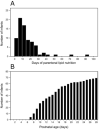Influence of Human Milk and Parenteral Lipid Emulsions on Serum Fatty Acid Profiles in Extremely Preterm Infants
- PMID: 29679529
- PMCID: PMC6437763
- DOI: 10.1002/jpen.1172
Influence of Human Milk and Parenteral Lipid Emulsions on Serum Fatty Acid Profiles in Extremely Preterm Infants
Abstract
Background: Infants born prematurely are at risk of a deficiency in ω-6 and ω-3 long-chain polyunsaturated fatty acids (LC-PUFAs) arachidonic acid (AA) and docosahexaenoic acid (DHA). We investigated how fatty acids from breast milk and parenteral lipid emulsions shape serum LC-PUFA profiles in extremely preterm infants during early perinatal life.
Methods: Ninety infants born < 28 weeks gestational age were randomized to receive parenteral lipids with or without the ω-3 LC-PUFAs eicosapentaenoic acid (EPA) and DHA (SMOFlipid: Fresenius Kabi, Uppsala, Sweden, or Clinoleic: Baxter Medical AB, Kista, Sweden, respectively). The fatty acid composition of infant serum phospholipids was determined from birth to postmenstrual age 40 weeks, and in mother's milk total lipids on postnatal day 7. Enteral and parenteral intake of LC-PUFAs was correlated with levels in infant serum.
Results: Infants administered parenteral ω-3 LC-PUFAs received 4.4 and 19.3 times more DHA and EPA, respectively, over the first 2 weeks of life. Parenteral EPA but not DHA correlated with levels in infant serum. We found linear relationships between dietary EPA and DHA and infant serum levels in the Clinoleic (Baxter Medical AB) group. The volume of administered SMOFlipid (Fresenius Kabi) was inversely correlated with serum AA, whereas Clinoleic (Baxter Medical AB) inversely correlated with serum EPA and DHA.
Conclusions: There appears to be no or low correlation between the amount of DHA administered parenterally and levels measured in serum. Whether this observation reflects serum phospholipid fraction only or truly represents the amount of accreted DHA needs to be investigated. None of the parenteral lipid emulsions satisfactorily maintained high levels of both ω-6 and ω-3 LC-PUFAs in infant serum.
Keywords: arachidonic acid; docosahexaenoic acid (DHA); extremely preterm; human milk; long-chain polyunsaturated fatty acids (LC-PUFA); parenteral nutrition.
© 2018 The Authors. Journal of Parenteral and Enteral Nutrition published by American Society for Parenteral and Enteral Nutrition.
Figures





Similar articles
-
Modification of serum fatty acids in preterm infants by parenteral lipids and enteral docosahexaenoic acid/arachidonic acid: A secondary analysis of the Mega Donna Mega trial.Clin Nutr. 2023 Jun;42(6):962-971. doi: 10.1016/j.clnu.2023.04.020. Epub 2023 Apr 17. Clin Nutr. 2023. PMID: 37120902 Free PMC article. Clinical Trial.
-
Effects of a lipid emulsion containing fish oil on polyunsaturated fatty acid profiles, growth and morbidities in extremely premature infants: A randomized controlled trial.Clin Nutr ESPEN. 2017 Aug;20:17-23. doi: 10.1016/j.clnesp.2017.04.004. Epub 2017 May 3. Clin Nutr ESPEN. 2017. PMID: 29072164 Free PMC article. Clinical Trial.
-
Extremely preterm infants receiving standard care receive very low levels of arachidonic and docosahexaenoic acids.Clin Nutr. 2017 Dec;36(6):1593-1600. doi: 10.1016/j.clnu.2016.09.033. Epub 2016 Oct 8. Clin Nutr. 2017. PMID: 27756480
-
The role of polyunsaturated fatty acids in term and preterm infants and breastfeeding mothers.Pediatr Clin North Am. 2001 Feb;48(1):173-88. doi: 10.1016/s0031-3955(05)70292-3. Pediatr Clin North Am. 2001. PMID: 11236724 Review.
-
Enteral and parenteral lipid requirements of preterm infants.World Rev Nutr Diet. 2014;110:82-98. doi: 10.1159/000358460. Epub 2014 Apr 11. World Rev Nutr Diet. 2014. PMID: 24751623 Review.
Cited by
-
Sphingolipidomics of serum in extremely preterm infants: Association between low sphingosine-1-phosphate levels and severe retinopathy of prematurity.Biochim Biophys Acta Mol Cell Biol Lipids. 2021 Jul;1866(7):158939. doi: 10.1016/j.bbalip.2021.158939. Epub 2021 Apr 20. Biochim Biophys Acta Mol Cell Biol Lipids. 2021. PMID: 33862236 Free PMC article.
-
FGF21 via mitochondrial lipid oxidation promotes physiological vascularization in a mouse model of Phase I ROP.Angiogenesis. 2023 Aug;26(3):409-421. doi: 10.1007/s10456-023-09872-x. Epub 2023 Mar 21. Angiogenesis. 2023. PMID: 36943533 Free PMC article.
-
Lipid profiling of suction blister fluid: comparison of lipids in interstitial fluid and plasma.Lipids Health Dis. 2019 Aug 24;18(1):164. doi: 10.1186/s12944-019-1107-3. Lipids Health Dis. 2019. PMID: 31443723 Free PMC article.
-
Modification of serum fatty acids in preterm infants by parenteral lipids and enteral docosahexaenoic acid/arachidonic acid: A secondary analysis of the Mega Donna Mega trial.Clin Nutr. 2023 Jun;42(6):962-971. doi: 10.1016/j.clnu.2023.04.020. Epub 2023 Apr 17. Clin Nutr. 2023. PMID: 37120902 Free PMC article. Clinical Trial.
-
A Mixed Lipid Emulsion Containing Fish Oil and Its Effect on Electrophysiological Brain Maturation in Infants of Extremely Low Birth Weight: A Secondary Analysis of a Randomized Clinical Trial.J Pediatr. 2019 Aug;211:46-53.e2. doi: 10.1016/j.jpeds.2019.03.039. Epub 2019 Apr 25. J Pediatr. 2019. PMID: 31030946 Free PMC article. Clinical Trial.
References
-
- Driscoll DF, Bistrian BR, Demmelmair H, Koletzko B. Pharmaceutical and clinical aspects of parenteral lipid emulsions in neonatology. Clin Nutr 2008;27:497‐503. - PubMed
-
- Fang PC, Kuo HK, Huang CB, Ko TY, Chen CC, Chung MY. The effect of supplementation of docosahexaenoic acid and arachidonic acid on visual acuity and neurodevelopment in larger preterm infants. Chang Gung Med J 2005;28:708‐715. - PubMed
-
- Wang Q, Cui Q, Yan C. The effect of supplementation of long‐chain polyunsaturated fatty acids during lactation on neurodevelopmental outcomes of preterm infant from infancy to school age: a systematic review and meta‐analysis. Pediatr Neurol 2016;59:54‐61.e1. - PubMed
-
- Lapillonne A. Enteral and parenteral lipid requirements of preterm infants. World Rev Nutr Diet 2014;110:82‐98. - PubMed
Publication types
MeSH terms
Substances
Grants and funding
LinkOut - more resources
Full Text Sources
Other Literature Sources
Medical
Research Materials

